Biochemical Characterization of a Non-G4-Type RNA Aptamer That Lights Up a GFP-like Fluorogenic Ligand
Abstract
1. Introduction
2. Results
2.1. Fluorescent Properties of the DMHBI/17-3 Complex
2.2. Identification of the Essential Elements of 17-3 RNA to Generate Karashi RNA
2.3. Chemical Probing of Karashi (17-3min) RNA and Its Circular Permutant
2.4. Tertiary Structure Prediction of Karashi (17-3min) Aptamer by AlphaFold3
3. Discussion
4. Materials and Methods
4.1. Chemicals
4.2. RNA Preparation
4.3. Standard Assay Conditions for the Fluorescence of DMHBI Complexed with the 17-3 RNA and Its Derivatives
4.4. Chemical Modification of 17-3blunt RNA and 17-3CP RNA with CMCT
4.5. Chemical Modification of 17-3blunt RNA and 17-3CP RNA with DMS
4.6. Chemical Modification of 17-3blunt RNA and 17-3CP RNA with NMIA
4.7. Reverse Transcription of Chemically Modified RNAs and Electrophoresis of the Resulting cDNAs
5. Conclusions
Supplementary Materials
Author Contributions
Funding
Institutional Review Board Statement
Informed Consent Statement
Data Availability Statement
Acknowledgments
Conflicts of Interest
Abbreviations
| DFHBI | 3,5-difluoro-4-hydroxy-benzylidene imidazolinone |
| HBI | 4-hydroxy-benzylidene imidazolinone |
| DMHBI | 3,5-dimethoxy-4-hydroxy-benzylidene imidazolinone |
| CMCT | N-cyclohexyl-N′-β-(4-methylmorpholinium) ethylcarbodiimide p-toluenesulfonate |
| DMS | dimethyl sulfate |
| NMIA | N-methylisatoic anhydride |
References
- Lei, X.; Xia, Y.; Ma, X.; Wang, L.; Wu, Y.; Wu, X.; Yang, Z.; Wang, S.; Ren, X. Illuminating RNA through fluorescent light-up RNA aptamers. Biosens. Bioelectron. 2025, 271, 116969. [Google Scholar] [CrossRef] [PubMed]
- Lu, X.; Kong, K.Y.S.; Unrau, P.J. Harmonizing the growing fluorogenic RNA aptamer toolbox for RNA detection and imaging. Chem. Soc. Rev. 2023, 2, 4071–4098. [Google Scholar] [CrossRef] [PubMed]
- Trachman, R.J.; Ferré-D’Amaré, A.R. Tracking RNA with light: Selection, structure, and design of fluorescence turn-on RNA aptamers. Q. Rev. Biophys. 2019, 52, e8. [Google Scholar] [CrossRef] [PubMed]
- Truong, L.; Ferré-D’Amaré, A.R. From fluorescent proteins to fluorogenic RNAs: Tools for imaging cellular macromolecules. Protein Sci. 2019, 28, 1374–1386. [Google Scholar] [CrossRef]
- Bouhedda, F.; Autour, A.; Ryckelynck, M. Light-up RNA aptamers and their cognate fluorogens: From their development to their applications. Int. J. Mol. Sci. 2017, 19, 44. [Google Scholar] [CrossRef]
- Babendure, J.R.; Adams, S.R.; Tsien, R.Y. Aptamers switch on fluorescence of triphenylmethane dyes. J. Am. Chem. Soc. 2003, 125, 14716–14717. [Google Scholar] [CrossRef]
- Sando, S.; Narita, A.; Hayami, M.; Aoyama, Y. Transcription monitoring using fused RNA with a dye-binding light-up aptamer as a tag: A blue fluorescent RNA. Chem. Commun. 2008, 3858–3860. [Google Scholar] [CrossRef]
- Paige, J.S.; Wu, K.Y.; Jaffrey, S.R. RNA mimics of green fluorescent protein. Science 2011, 333, 642–646. [Google Scholar] [CrossRef]
- Paige, J.S.; Nguyen-Duc, T.; Song, W.; Jaffrey, S.R. Fluorescence imaging of cellular metabolites with RNA. Science 2012, 335, 1194. [Google Scholar] [CrossRef]
- Steinmetzger, C.; Palanisamy, N.; Gore, K.R.; Höbartner, C. A Multicolor large Stokes shift fluorogen-activating RNA aptamer with cationic chromophores. Chem. Eur. J. 2019, 25, 1931–1935. [Google Scholar] [CrossRef]
- Steinmetzger, C.; Bessi, I.; Lenz, A.K.; Höbartner, C. Structure-fluorescence activation relationships of a large Stokes shift fluorogenic RNA aptamer. Nucleic Acids Res. 2019, 47, 11538–11550. [Google Scholar] [PubMed]
- Mieczkowski, M.; Steinmetzger, C.; Bessi, I.; Lenz, A.K.; Schmiedel, A.; Holzapfel, M.; Lambert, C.; Pena, V.; Höbartner, C. Large Stokes shift fluorescence activation in an RNA aptamer by intermolecular proton transfer to guanine. Nat. Commun. 2021, 12, 3549. [Google Scholar] [CrossRef] [PubMed]
- Yasmeen, A.; Du, F.; Zhao, Y.; Dong, J.; Chen, H.; Huang, X.; Cui, X.; Tang, Z. Sequence-specific biosensing of DNA target through relay PCR with small-molecule fluorophore. ACS Chem. Biol. 2016, 11, 1945–1951. [Google Scholar] [CrossRef] [PubMed]
- Banco, M.T.; Ferré-D’Amaré, A.R. The emerging structural complexity of G-quadruplex RNAs. RNA 2021, 27, 390–402. [Google Scholar]
- Umar, M.I.; Ji, D.; Chan, C.Y.; Kwok, C.K. G-quadruplex-based fluorescent turn-on ligands and aptamers: From development to applications. Molecules 2019, 24, 2416. [Google Scholar] [CrossRef]
- Jacobson, A.B.; Zuker, M. Structural analysis by energy dot plot of a large mRNA. J. Mol. Biol. 1993, 233, 261–269. [Google Scholar] [CrossRef]
- Zuker, M. Mfold web server for nucleic acid folding and hybridization prediction. Nucleic Acids Res. 2003, 31, 3406–3415. [Google Scholar] [CrossRef]
- Sato, K.; Akiyama, M.; Sakakibara, Y. RNA secondary structure prediction using deep learning with thermodynamic integration. Nat. Commun. 2021, 12, 941. [Google Scholar]
- Zadeh, J.N.; Steenberg, C.D.; Bois, J.S.; Wolfe, B.R.; Pierce, M.B.; Khan, A.R.; Dirks, R.M.; Pierce, N.A. NUPACK: Analysis and design of nucleic acid systems. J. Comput. Chem. 2011, 32, 170–173. [Google Scholar] [CrossRef]
- Mandiyan, V.; Boublik, M. Structural analysis of the 5′ domain of the HeLa 18S ribosomal RNA by chemical and enzymatic probing. Nucleic Acids Res. 1990, 18, 7055–7062. [Google Scholar] [CrossRef]
- Andrade, J.M.; Dos Santos, R.F.; Arraiano, C.M. RNA Structure analysis by chemical probing with DMS and CMCT. Methods Mol. Biol. 2020, 2106, 209–223. [Google Scholar] [PubMed]
- Alghoul, F.; Eriani, G.; Martin, F. RNA secondary structure study by chemical probing methods using DMS and CMCT. Methods Mol. Biol. 2021, 2300, 241–250. [Google Scholar] [PubMed]
- Merino, E.J.; Wilkinson, K.A.; Coughlan, J.L.; Weeks, K.M. RNA structure analysis at single nucleotide resolution by selective 2′-hydroxyl acylation and primer extension (SHAPE). J. Am. Chem. Soc. 2005, 127, 4223–4231. [Google Scholar] [CrossRef] [PubMed]
- Wilkinson, K.A.; Merino, E.J.; Weeks, K.M. Selective 2′-hydroxyl acylation analyzed by primer extension (SHAPE): Quantitative RNA structure analysis at single nucleotide resolution. Nat. Protoc. 2006, 1, 1610–1616. [Google Scholar] [CrossRef]
- Cheng, Q.Y.; Xiong, J.; Ma, C.J.; Dai, Y.; Ding, J.H.; Liu, F.L.; Yuan, B.F.; Feng, Y.Q. Chemical tagging for sensitive determination of uridine modifications in RNA. Chem Sci. 2020, 11, 1878–1891. [Google Scholar] [CrossRef]
- Fabian, M.R.; Na, H.; Ray, D.; White, K.A. 3′-Terminal RNA secondary structures are important for accumulation of tomato bushy stunt virus DI RNAs. Virology 2003, 313, 567–580. [Google Scholar] [CrossRef]
- Cheong, C.; Varani, G.; Tinoco, I., Jr. Solution structure of an unusually stable RNA hairpin, 5′GGAC(UUCG)GUCC. Nature 1990, 346, 680–682. [Google Scholar] [CrossRef]
- Abramson, J.; Adler, J.; Dunger, J.; Evans, R.; Green, T.; Pritzel, A.; Ronneberger, O.; Willmore, L.; Ballard, A.J.; Bambrick, J.; et al. Accurate structure prediction of biomolecular interactions with AlphaFold 3. Nature 2024, 630, 493–500. [Google Scholar] [CrossRef]
- Truong, L.; Kooshapur, H.; Dey, S.K.; Li, X.; Tjandra, N.; Jaffrey, S.R.; Ferré-D’Amaré, A.R. The fluorescent aptamer Squash extensively repurposes the adenine riboswitch fold. Nat. Chem. Biol. 2022, 18, 191–198. [Google Scholar] [CrossRef]
- Tosar, J.P.; Witwer, K.; Cayota, A. Revisiting extracellular RNA release, processing, and function. Trends Biochem. Sci. 2021, 46, 438–445. [Google Scholar] [CrossRef]
- Guo, J.U.; Bartel, D.P. RNA G-quadruplexes are globally unfolded in eukaryotic cells and depleted in bacteria. Science 2016, 353, aaf5371. [Google Scholar] [CrossRef] [PubMed]
- Autour, A.; Westhof, E.; Ryckelynck, M. iSpinach: A fluorogenic RNA aptamer optimized for in vitro applications. Nucleic Acids Res. 2016, 44, 2491–2500. [Google Scholar] [PubMed]
- Autour, A.; Jeng, S.C.Y.; Cawte, A.D.; Abdolahzadeh, A.; Galli, A.; Panchapakesan, S.S.S.; Rueda, D.; Ryckelynck, M.; Unrau, P.J. Fluorogenic RNA Mango aptamers for imaging small non-coding RNAs in mammalian cells. Nat. Commun. 2018, 9, 656. [Google Scholar] [CrossRef] [PubMed]
- Chen, X.; Zhang, D.; Su, N.; Bao, B.; Xie, X.; Zuo, F.; Yang, L.; Wang, H.; Jiang, L.; Lin, Q.; et al. Visualizing RNA dynamics in live cells with bright and stable fluorescent RNAs. Nat. Biotechnol. 2019, 37, 1287–1293. [Google Scholar]
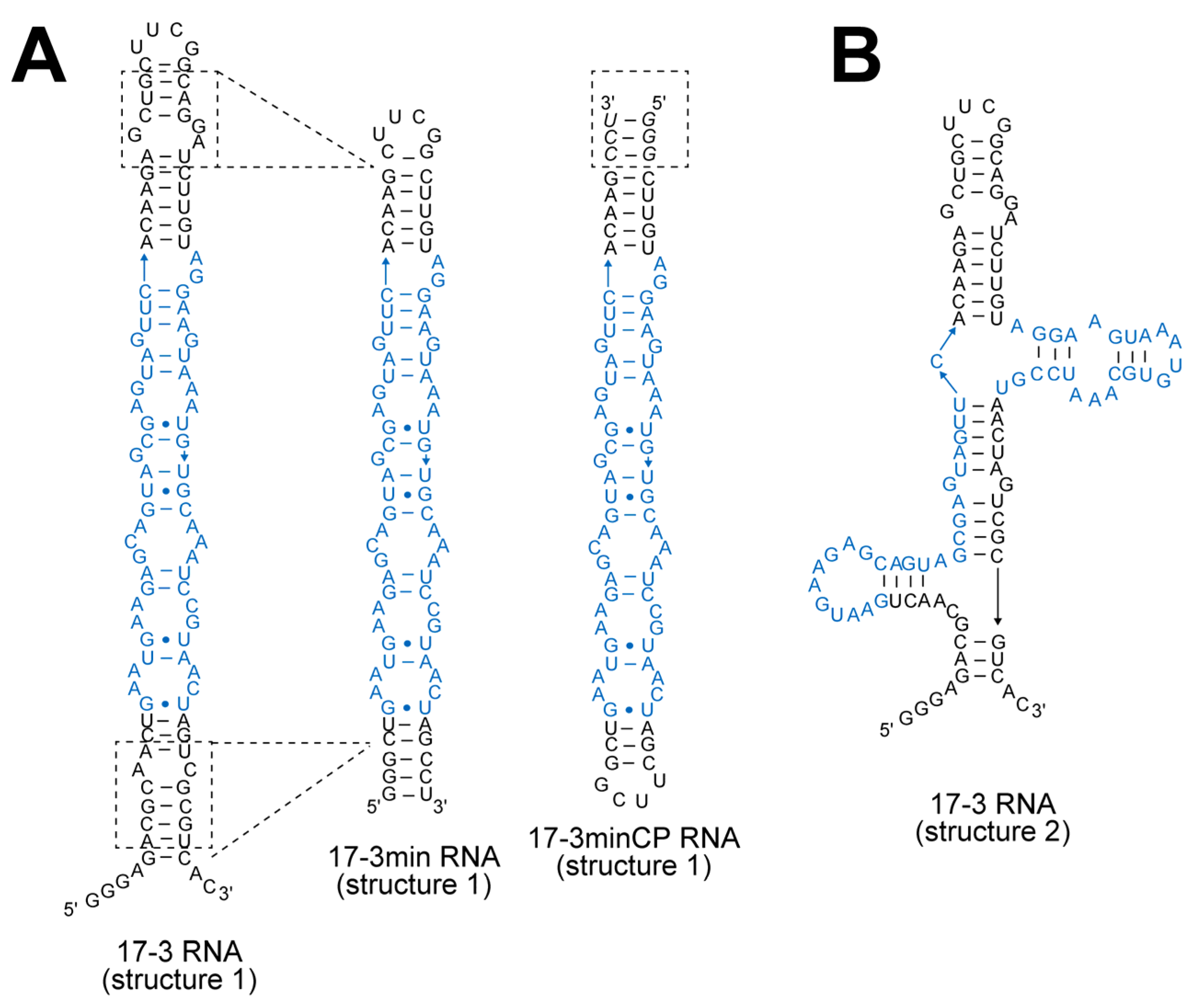
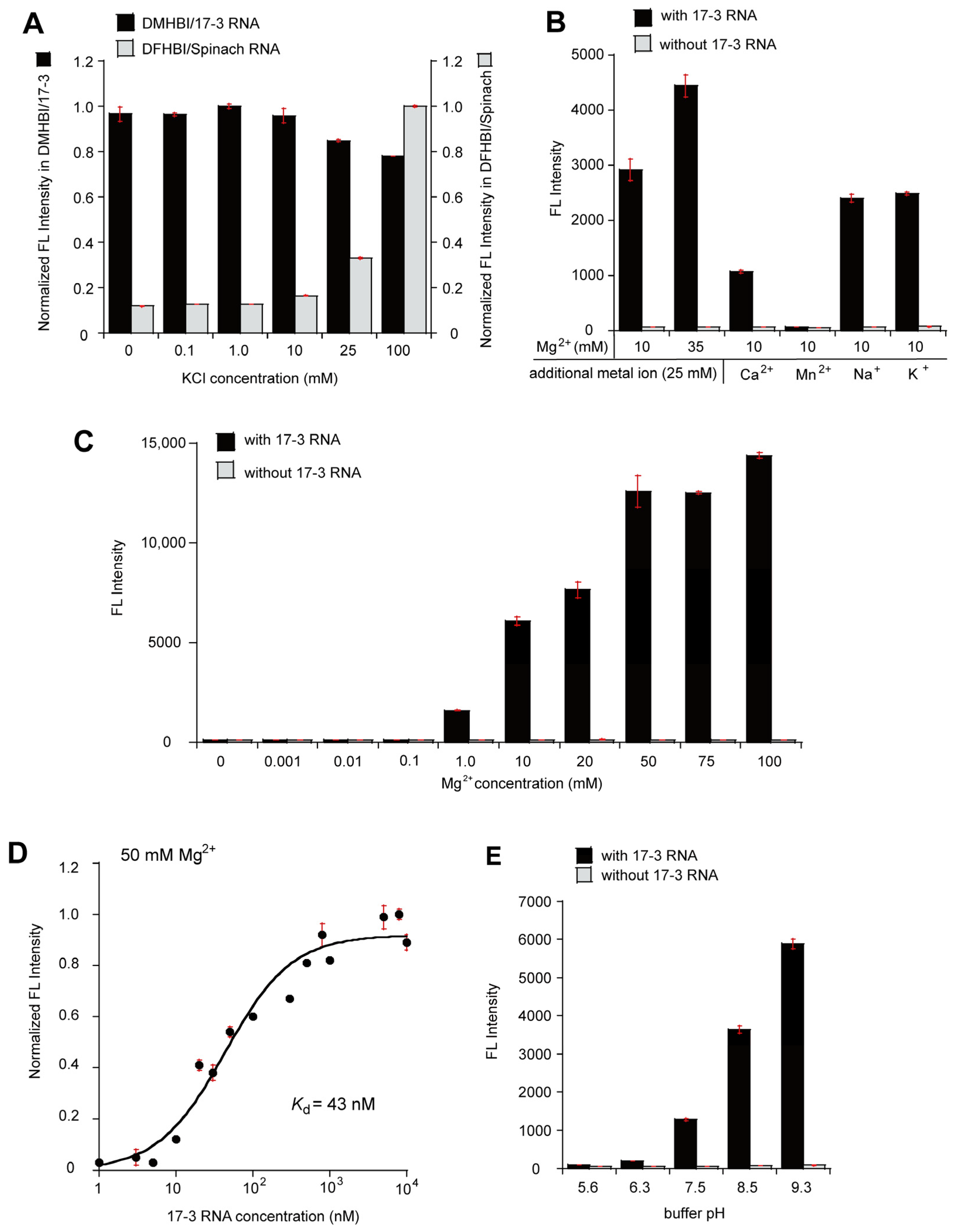
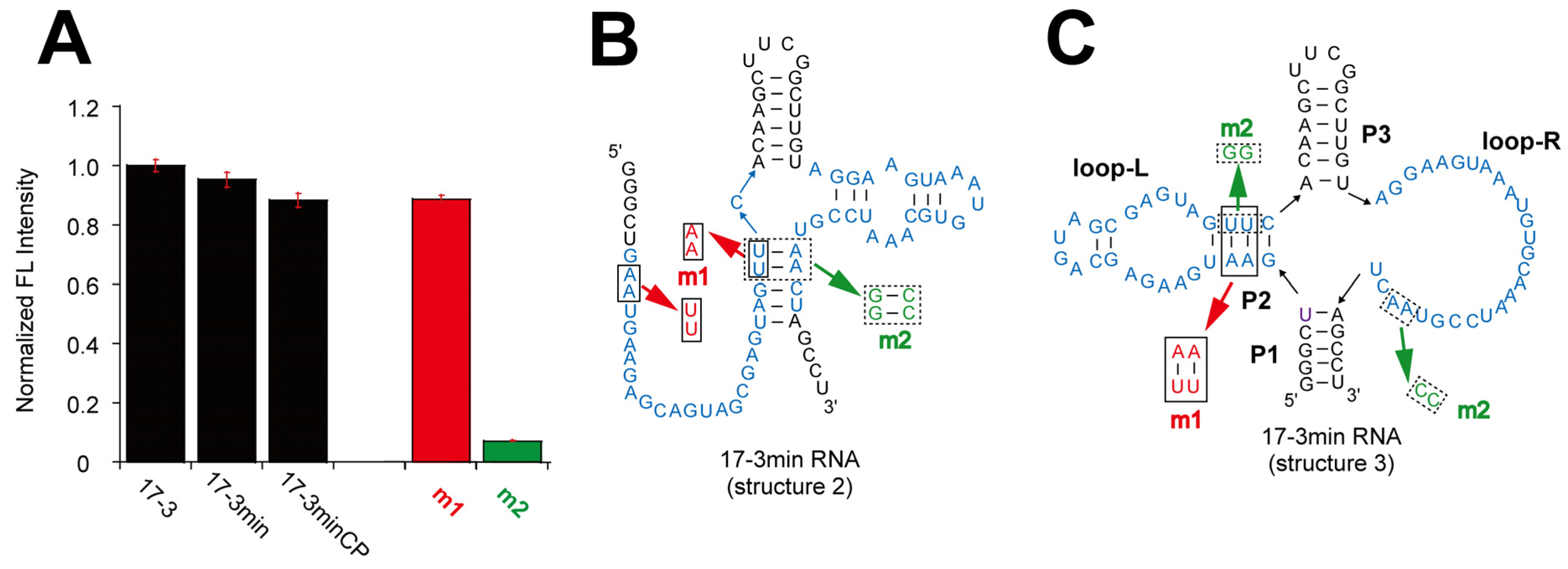

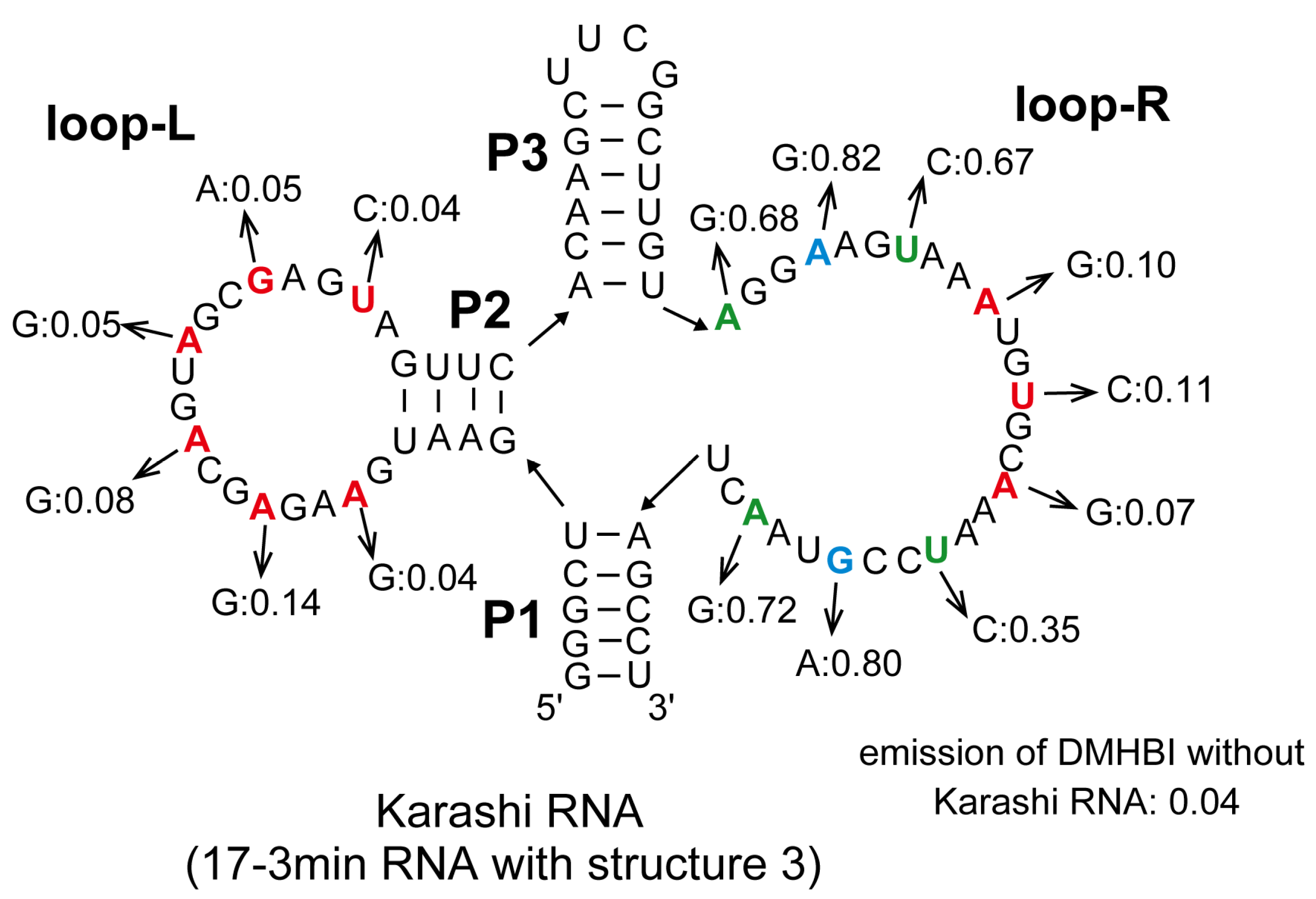

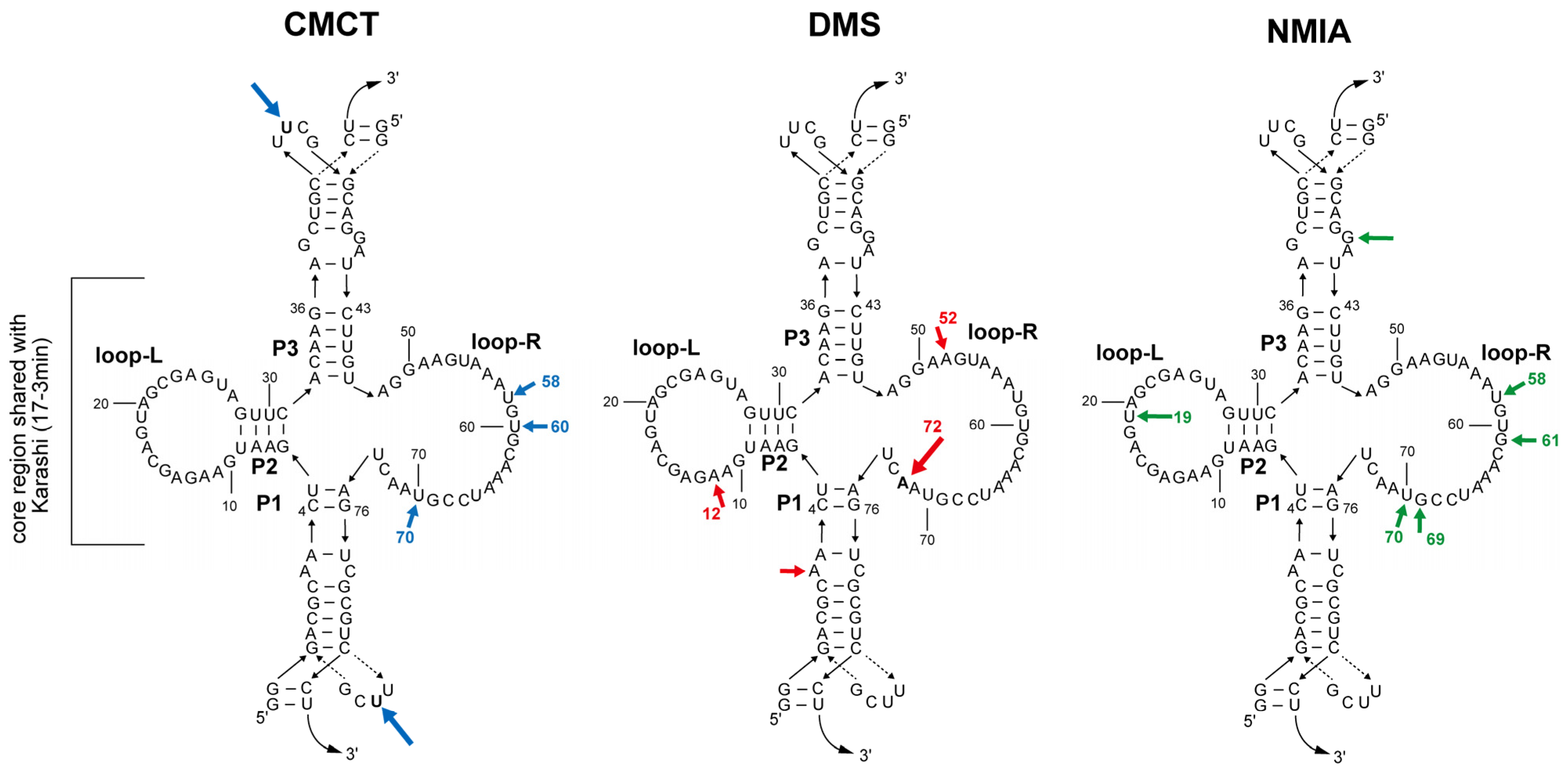
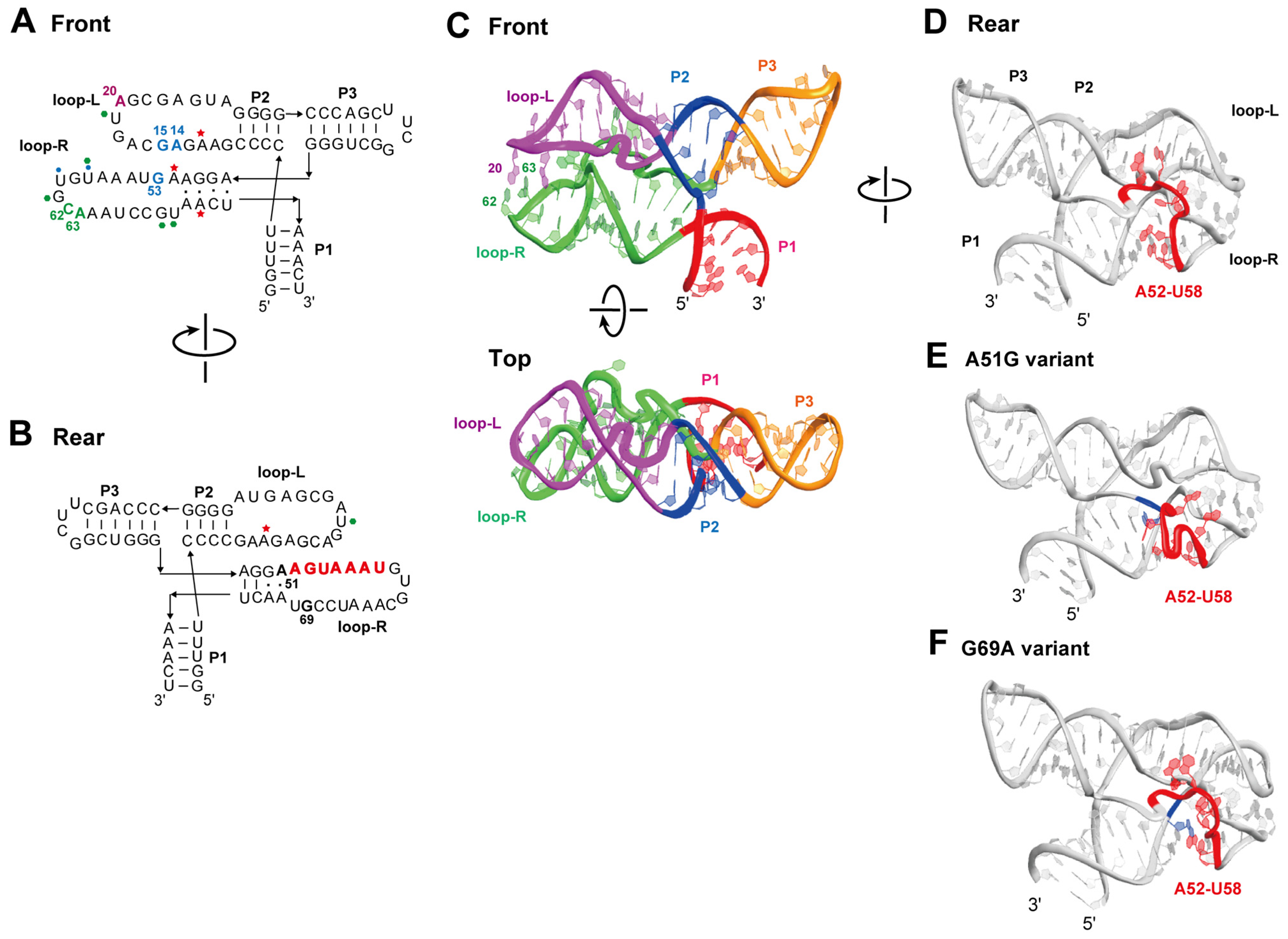
Disclaimer/Publisher’s Note: The statements, opinions and data contained in all publications are solely those of the individual author(s) and contributor(s) and not of MDPI and/or the editor(s). MDPI and/or the editor(s) disclaim responsibility for any injury to people or property resulting from any ideas, methods, instructions or products referred to in the content. |
© 2025 by the authors. Licensee MDPI, Basel, Switzerland. This article is an open access article distributed under the terms and conditions of the Creative Commons Attribution (CC BY) license (https://creativecommons.org/licenses/by/4.0/).
Share and Cite
Abe, S.; Aburaya, S.; Koyama, T.; Usui, T.; Yoshino, J.; Matsumura, S.; Ikawa, Y. Biochemical Characterization of a Non-G4-Type RNA Aptamer That Lights Up a GFP-like Fluorogenic Ligand. Molecules 2025, 30, 1777. https://doi.org/10.3390/molecules30081777
Abe S, Aburaya S, Koyama T, Usui T, Yoshino J, Matsumura S, Ikawa Y. Biochemical Characterization of a Non-G4-Type RNA Aptamer That Lights Up a GFP-like Fluorogenic Ligand. Molecules. 2025; 30(8):1777. https://doi.org/10.3390/molecules30081777
Chicago/Turabian StyleAbe, Shunsuke, Shino Aburaya, Takaki Koyama, Takashi Usui, Junro Yoshino, Shigeyoshi Matsumura, and Yoshiya Ikawa. 2025. "Biochemical Characterization of a Non-G4-Type RNA Aptamer That Lights Up a GFP-like Fluorogenic Ligand" Molecules 30, no. 8: 1777. https://doi.org/10.3390/molecules30081777
APA StyleAbe, S., Aburaya, S., Koyama, T., Usui, T., Yoshino, J., Matsumura, S., & Ikawa, Y. (2025). Biochemical Characterization of a Non-G4-Type RNA Aptamer That Lights Up a GFP-like Fluorogenic Ligand. Molecules, 30(8), 1777. https://doi.org/10.3390/molecules30081777





